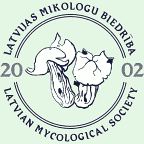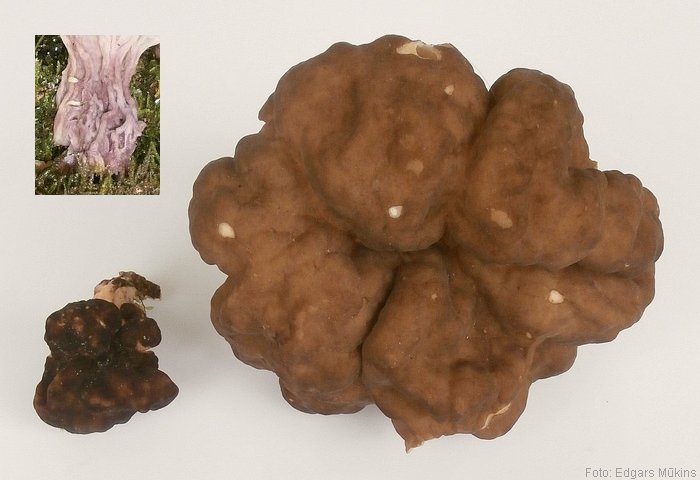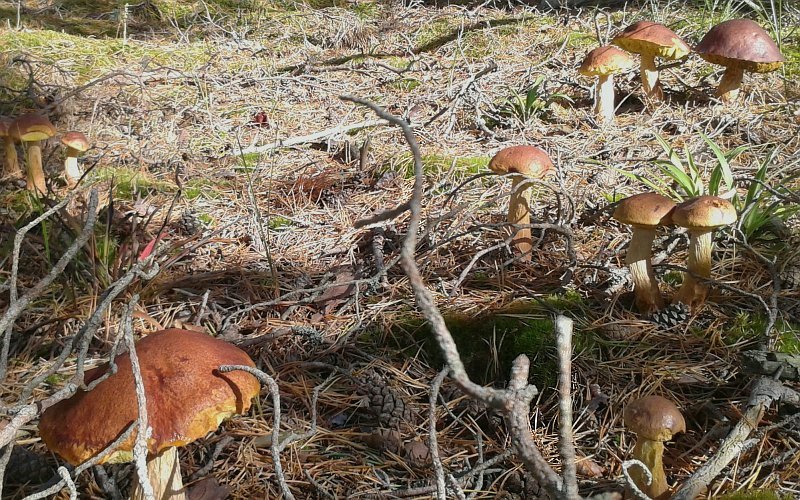 |
MYCOLOGICAL NEWS FROM LATVIA |
||||||||||||||||||||||||||||
|
|
Currently in this chapter: ● Gyromitra sphaerospora in Latvia (last updated in January, 2019) ● Several more boletes in Latvia (last updated in January, 2019) ● Boletus projectellus in Latvia (last updated in January, 2019; first published on September 24, 2014) Gyromitra sphaerospora in Latvia Short note The very rare species of Gyromitra sphaerospora has been found in Latvia at a single location in June 2017. Just few specimens were present in the narrow valley of a small stream. Similar number of specimens was found there in 2018.
More info (unfortunately, mostly in Latvian) on those findings is available on the privately-run senes.lv website here.
Edgars Mukins, Last updated in January, 2019 Several more boletes in Latvia Fact sheet Early this century, the number of bolete species, known to be present in Latvia, has risen significantly: by eight. Boletus appendiculatus: just a single specimen has been found in a forest north of the town of Aizpute in 2017. Boletus fechtneri: two specimens have been found (a month apart) at a location near the town of Talsi in 2014. Boletus projectellus: almost countless specimens have been collected at numerous locations along the entire Baltic shoreline and at few inland locations since 2013 (incl. one 200 km from the coast). See the Preliminary Report below. Boletus pulverulentus: numerous specimens have been found in a century-old park in Kazdanga parish in 2013. Leccinum crocipodium: two dozens of specimens have been found in a small region north of Aizpute since 2016. Leccinum pseudoscabrum: few dozens of specimens have been found around Sigulda and elsewhere since 2010. Xerocomus bubalinus: numerous specimens have been found at a wide variety of locations (almost exclusively - urban ones) across the country since 2004 (however, the species was identified with certainty only in 2012). Xerocomus pruinatus: up to a dozen specimens per year have been observed within a Riga cemetery since 2010, as well as very few specimens in/around Sigulda in 2016. More info on those findings is available both on our Society's website and on the privately-run senes.lv website:
For even more info on B.projectellus, L.pseudoscabrum, X.bubalinus, X.pruinatus in Latvia,
contact the undersigned.
Edgars Mukins, Last updated in January, 2019 Boletus projectellus in Latvia Preliminary report Latvia has become the second known European country (after Lithuania) to host the North-American species of Boletus projectellus (Murrill) Murrill. In September 2013, several specimens of an unfamiliar bolete were collected by non-mycologists at various locations along the Baltic seashore and brought to the Latvian Museum of Natural History, where the annual mushroom exhibition was taking place. Almost immediately they were recognized as Boletus projectellus by the undersigned. Subsequent detailed discussions with the involved mushroom-hunters led to a conclusion, that at least several dozen specimens had been either taken for delivery to the Museum’s exhibition, or collected for consumption, or discarded immediately after being cut. All known specimens were found growing in a narrow dune-covered coastal zone, within slightly less than 1 km from the waterfront. Most specimens had been collected in a popular recreation and mushroom-hunting area adjacent to Riga, and just a few – at isolated locations elsewhere along the shoreline. Having been declared the Fungus of the Year 2014 by the Latvian Mycological Society and hence having been prominently exposed by both national and regional mass media, Boletus projectellus attracted considerable attention by the general public during this year’s mushroom-hunting season. As a result, numerous reports on new occurrences of the species started pouring in already in late August. Specimens from several locations were brought to the Latvian Museum of Natural History, dozens of e-mail reports were received by the Museum, the Latvian Mycological Society and senes.lv website. The vast majority of reports included photographs clear enough to confirm the species with certainty. Few reports still continue coming in occasionally. All reports are accumulated at senes.lv and are to be properly summarized and analyzed after the end of the season. Preliminary results are sketched below. The specimens of the species have been found along the entire Latvia’s Baltic seashore, starting with a location ~25 km from Lithuanian border (south-west from Nīca) and ending with a location ~30 km from Estonian border (10 km north from Tūja). No remarkable gaps remain in that coastal zone coverage. Most reports tell about findings in a 30 km stretch immediately northeast to Riga, from Vecāķi to Saulkrasti. We suspect that such a concentration of cases is due merely to the high population density in that resort area and to its popularity as mushroom-hunting grounds among both the locals and the inhabitants of nearby Riga. In each case, from one to about 20 fruit-bodies have been observed at a single location, with just a few in typical cases. Together with the discarded specimens, which had been subsequently noticed and counted by the reporting persons, the known total for 2014 runs into hundreds of specimens. The vast majority of reported occurrences are concentrated within a very narrow coastal zone, starting at only dozens of meters from the waterfront (in places where the beach is particularly narrow) and expanding approximately one kilometer inland. A limited number of occurrences lie barely outside that zone, up to few kilometers from the shoreline. In virtually all the cases, the specimens have been found growing on coastal sand dunes under pines or on similar sandy soil. However, there are three reports, well confirmed photographically, on the species having been observed rather deeply inland, namely, ~25 km, 40 km and 51 km from the Baltic seashore. In one case, the mushrooms have been growing on dry sandy soil, while in the two others – on dried-out peat bogs. At the most coast-distant location, the group has numbered about 50 fruit-bodies – the largest one noticed in Latvia so far (an extensive photographic proof of that has been received at senes.lv). Moreover, there is a report on a specimen found slightly over 100 km from the Baltic shoreline. Though originating from a person with a biological background, the report does not include either the sample or a photograph, and therefore is not considered fully convincing. During the campaign, few reports on pre-2013 findings of the species in Latvia’s coastal zone have also been received. A particularly detailed report, sent to senes.lv, describes three fruit-bodies having been found back in 2011; however, the observer has been unable to recover the photograph he had reportedly taken at that time. Some visitors of the mushroom exhibition at the Museum of Natural History have told about single (or very few) specimens having been observed at certain fixed locations for up to 10 or more years into the past. However, those reports lack details and any sort of hard evidence.
© Edgars Mukins, Published on September 24, 2014 P.S. In 2015, Boletus projectellus has been reported prominently by mushroom-hunters once again. At a newly found seashore locality, almost 300 specimens had been counted, while at last year's deepest-inland locality the number of specimens had doubled, exceeding 100 this year. The numbers have risen sharply at some other known localities, too. In 2016, mushroom-hunters have been more reluctant to report the species, which had lost its status of the Fungus of the Year quite a while ago. Nevertheless, few more productive localities were reported, including a new inland one. In 2018, a number of specimens have been found near the city of Daugavpils, 200 km from the seashore.
Last updated in January, 2019
|









